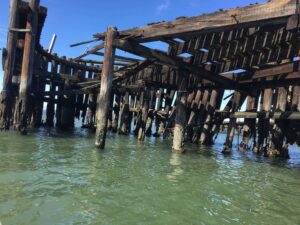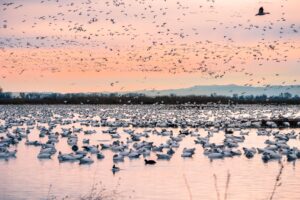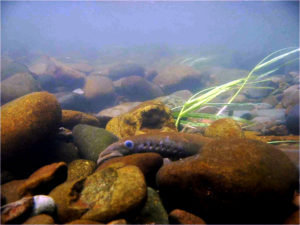Salmon eggs need river temperatures of 56 degrees or less to survive; at 62 degrees there is a 100 percent mortality rate. So when areas of the Sacramento River hit the low 60s in late August, it made a big splash.
The early fall Chinook (also known as king) spawning run is now taking place between Red Bluff and Redding, but prolonged drought has led to reduced flows from Lake Shasta and high water temperatures down river, a situation that could deal many egg nests a death blow. The dangerously warm water recently prompted the Golden Gate Salmon Association — a Petaluma-based coalition of salmon advocates — to call on federal and state agencies to act.
“In a good year, salmon will spawn in the last 60 miles of the river, but this year we don’t have 60 miles,” said John McManus, executive director of the GGSA. “Right now they are crowding into the upper 8 miles trying desperately to find a spot.”
In a recent open letter addressed to eight federal and state agencies, the GGSA proposed the collection and incubation of eggs from wild fish along with the injection of those eggs into spawning ground gravel when river temperatures begin to cool to favorable levels. The technique has been used successfully in Oregon and Alaska but not California. The decision on whether or not to move forward would be a joint one between California Department of Fish and Wildlife, National Marine Fisheries and the U.S. Fish and Wildlife Service. October’s weather will largely influence on the outcome.
“Nobody thinks it’s going to be a good year for egg survival,” said Robert Clarke, a Regional Fisheries Program supervisor at USFWS. But it’s difficult to predict precisely how many eggs will die, he said.
If the drought continues into the heart of the fall spawning season, Clarke said, it is likely that Coleman National Fish Hatchery, located about 20 miles southeast of Redding and managed by USFWS, would be the location for egg incubation. He said the staff there is currently analyzing its capacity to support egg incubation.
The theory behind the egg injection process is that it offers good hatch rates while only minimally altering natural traits, resulting in stronger fish with a better chance of returning to their natural streams than those raised in a hatchery. Only about 10 percent of salmon eggs survive in nature, but up to 90 percent could hatch if inserted correctly in gravel with a hydraulic egg-planting device, McManus said.
However, according to Jim Smith from USFWS’s Red Bluff office, if state and federal agencies do decide to take action, they are more likely to release into the river hatchery salmon fry — very young salmon minnows that live in fresh water —as opposed to injecting the eggs into the gravel. This process is easier than capturing wild and transporting them to the hatchery, Smith said, but this plan poses challenges as well. He said that between 85 to 90 percent of the salmon that return to the Coleman National Fish Hatchery have never spawned in the wild and instead swim back to the hatchery as adults to lay eggs in captivity.
“Because you are artificially selecting, your natural population loses its fitness,” Smith said. “It doesn’t produce as well as natural fish.”

The warm water that poses a threat to this year’s eggs also carries with it consequences that could reverberate for a long time to come.
“That can cascade down through the years,” Clarke said. “Salmon return in cycles, so if you have super low abundance one year, the loss of that year’s class carries through for a while.”
Even though a potential exists this year for a high mortality rate, high juvenile survival rates coupled with good ocean survivability in the first two years are still possible. “Those things might mitigate the low survivability of the eggs,” Clarke said.
Conversations between the agencies and the GGSA continue into September with all attention focused on this fall season’s weather. Meanwhile, trophy fish are being landed just outside the protected 12-mile stretch of spawning grounds.
“The river is teeming with salmon,” said professional fishing guide Dave Jacobs, whose said his group landed several 15-25 pound Chinook salmon while he talked on the phone from his boat. “I saw 50 on the surface today.”
Jacobs, who frequently measures water temperatures while fishing, said the 54-degree water near the Keswick dam is perfect for spawning. However, 50 miles down river he recorded it as high as 64 degrees, two degrees higher than the GGSA had announced. The result: cautious optimism for the fall and late-fall runs.
“I do believe there is going to be cold water when the fall salmon come,” he said. “But it could be a lot warmer a month from now. That’s still to be seen in October.”
The Keswick Dam is the northernmost boundary of the salmon spawning area. Fishing is banned all year round at the dam. The stretch of the Sacramento River from the dam to the Deschutes Bridge, a landmark river crossing about 12 miles south of Redding, constitutes what is left of the Chinook’s historic spawning grounds. Two of the Sacramento’s four distinct salmon runs — the winter and spring Chinook —are protected and listed as threatened under the Endangered Species Act.
California’s salmon industry is a $1.4 billion enterprise that employs over 20,000 workers annually. The historic spawning grounds for the fish in the Sacramento River have continually diminished since the 1940s due to the construction of the Shasta and Keswick dams.
In March, another inter-agency government effort transported 30 million Sacramento River salmon smolts to the ocean by truck to help the fish avoid harmful river conditions caused by the drought. It is unclear if such a plan will be repeated in spring.
Ted Andersen is a reporter at the UC Berkeley Graduate School of Journalism. This story was produced as part of a J-school class focusing of environmental issues in the Bay Area.





